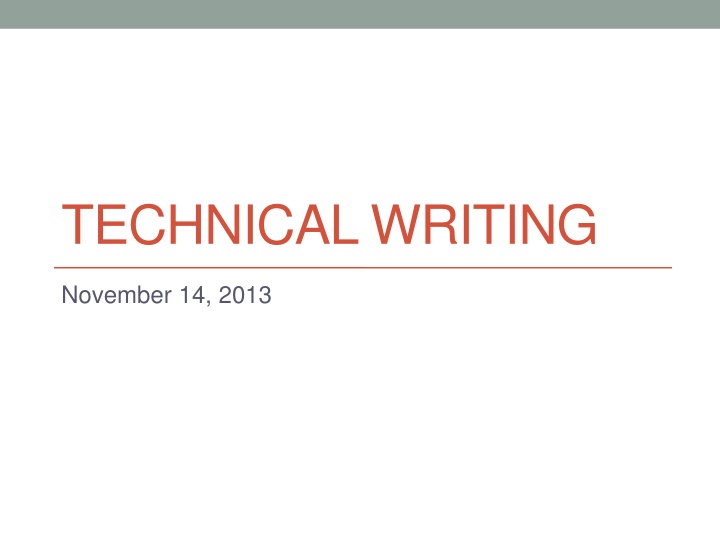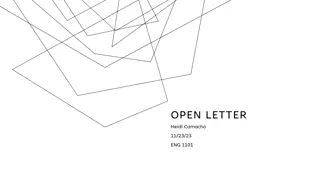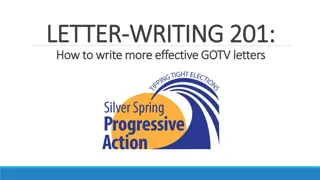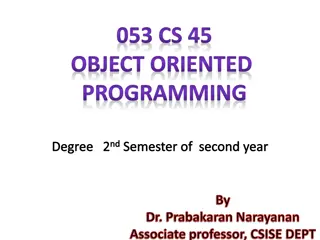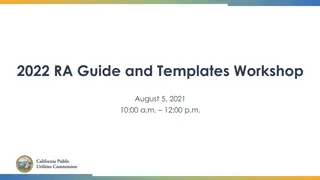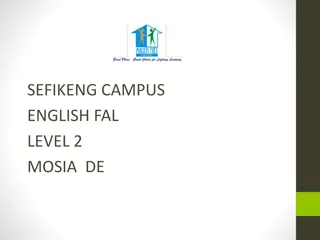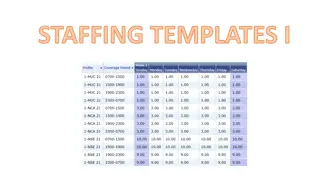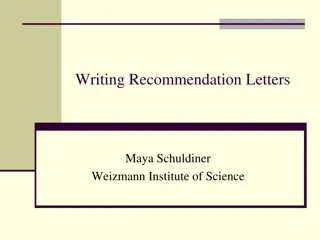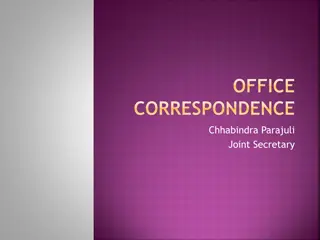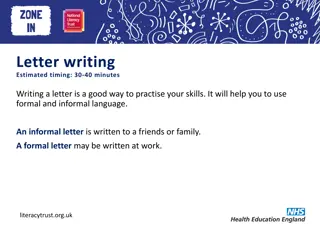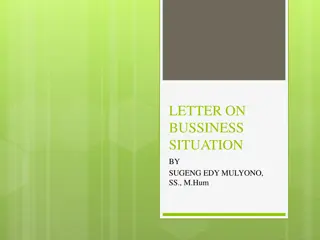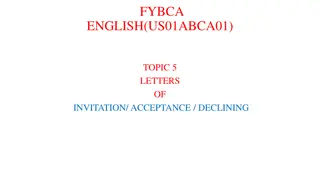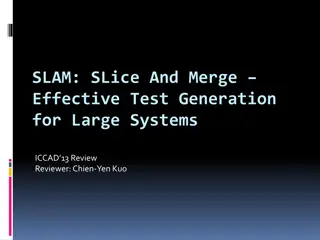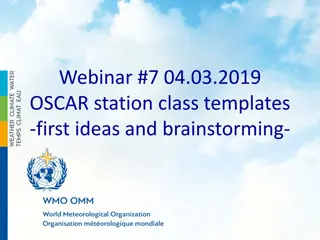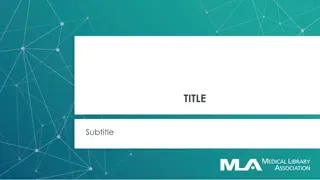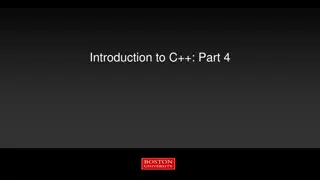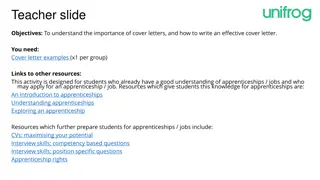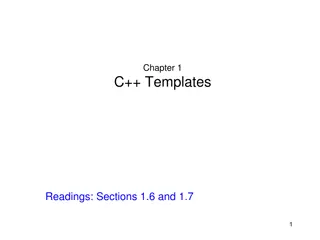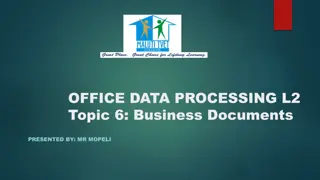Mastering Business Letters: Essential Tips and Templates
Dive into the world of business letters with this comprehensive guide covering essential topics such as language, structure, and parts of a letter. Learn the art of effective communication through standard organization practices and key elements like salutations, body paragraphs, and closing remarks. Explore diverse letter formats and get insights into adjustment letters to handle complaints effectively and professionally.
Uploaded on Sep 16, 2024 | 2 Views
Download Presentation

Please find below an Image/Link to download the presentation.
The content on the website is provided AS IS for your information and personal use only. It may not be sold, licensed, or shared on other websites without obtaining consent from the author.If you encounter any issues during the download, it is possible that the publisher has removed the file from their server.
You are allowed to download the files provided on this website for personal or commercial use, subject to the condition that they are used lawfully. All files are the property of their respective owners.
The content on the website is provided AS IS for your information and personal use only. It may not be sold, licensed, or shared on other websites without obtaining consent from the author.
E N D
Presentation Transcript
TECHNICAL WRITING November 14, 2013
Today Business letters (continued). Business letter language
Special Announcement Date: Monday November 25 (2:00 p.m. 5:00 p.m.) Location: Graduate School Building ( ) 4thfloor auditorium and 2ndfloor classrooms. American Chamber of Commerce (AmCham) Korea is bringing a special event to the KMU campus. CEOs for several high-profile international companies will be giving special lecture and small-group/one-on-one mentoring sessions.
Special Announcement Some CEOs attending: - Boeing - DuPont Chemical - Hewlett-Packard (HP) - Delphi - Intel - Kim & Chang Law Firm - Ford Motor Company Several others.
Business letters Usually represents a direct communication between one person and another. For example, a business letter is usually addressed specifically to someone (not writing for a general reader : To whom it may concern: ).
Parts of a business letter Heading Date line Inside (recipient s) address Salutation Body Complementary close Signature Enclosure (if necessary) Copy notation (if necessary)
Standard Organization To help readers grasp your message clearly and concisely, follow this simple plan: In your first paragraph tell readers why you are writing and why your letter is important to them. 1. Put the most significant point of each paragraph first to make it easier for the reader to find. 2. In the second and subsequent paragraphs of your letter, develop the body of your letter with factual support. 3. In your last paragraph, thank readers and be clear and precise about what you want them to do or what you will do for them. 4.
Adjustment Letters Adjustment letters respond to complaint letters and should restore customer confidence, whether the answer to what the customer wants done about the problem is yes or no. An adjustment letter saying yes should: Admit immediately that the customer s complaint is justified and apologize. State precisely what you are going to do to correct the problem. Tell customers exactly what happened. End on a friendly and positive note. 1. 2. 3. 4.
Adjustment Letters (continued) An adjustment letter saying no is more difficult, because it involves giving bad news while at the same time convincing the reader that your position is fair, logical, and consistent. A diplomatic adjustment letter saying no should: Thank customers for writing. State the problem carefully to reassure customers that you understand their complaint. Explain what happened with the product or service before you give the customer a decision. Give your decision without hedging. Leave the door open for better and continued business. 1. 2. 3. 4. 5.
Responds within complainant s specified time. Apologizes and announces good news. Explains what happened (the cause of the problem). Also explains why the problem will not recur the customer Closes with friendly offer of continued assistance. Expresses respect for
Guidelines for a yes letter 1. Immediately admit that the customer s complaint is justified and apologize. 2. State precisely what you will do to rectify the problem. - extend warranty coverage - cancel a bill - offer a discount - upgrade a product or service 3. Explain to the customer exactly what happened. - Provide only the essential details of the problem. - Do not try to infer blame. 4. End on a friendly, positive note
Responds within complainant s specified time. Buffer thanks and sympathizes with the reader. Explains problem but does not directly blame the reader. Turns a no into a yes . Gives a firm decision (and an explanation). Ends politely without referencing the problem again.
Guidelines for a no letter First, and most importantly: - Do not accuse, argue, scold, or blame. i.e., - You obviously didn t read the instruction manual. - The company policy plainly states that such refunds are not allowed. - You were negligent in operating the machine. - Your complaint is unjustified.
Real-life example Company: Discount-Mats.com A U.S. soldier stationed in Iraq inquired as to whether or not a mat company shipped overseas. He wanted to get the troops better gear to sleep on.
Real-life example the response From: contact@discount-mats.com Subject: Re: Feedback: from discount-mats.com SGT Hess, We do not ship to APO addresses, and even if we did, we would NEVER ship to Iraq. If you were sensible, you and your troops would pull out of Iraq. Bargain Suppliers Discount-Mats.com
Guidelines for a no letter 1. Thank the customer for writing. - Open with a polite, respectful comment ( buffer ) avoid: - I was surprised to learn that you found our product unsatisfactory. - There is no way that we could give you what you demand. 2. State the problem carefully to reassure the customer that you understand the complaint. 3. Explain what happened with the product/service before giving your decision. - Poor example: By reading the instructions on the side of the box, you would have avoided the over-heating problem that you claim resulted. - Improved: This product requires a cool environment, of 15 5 degrees for optimum operation.
Guidelines for a no letter 4. Give your decision without hedging. - Do not say, Perhaps some type of restitution could be made later. 5. Leave the door open for better and continued business. - Whenever possible, offer to send a new product or part, or install or repair a product for free or at a discount.
Sending Letter-Quality Messages: Final Advice Regardless of the type of business letter you write, the following guidelines will help you draft, tailor, and evaluate the letter to insure its quality: 1.Identify your reader. 2.Determine your purpose for writing. 3.Determine the reader s reason for writing. 4.Organize information. 5.Include essential information. 6.Use the appropriate style and tone.
Language used in business letters A letter that sounds impersonal and unfriendly can damage the image of an organization (even if just in the eyes of one or a few potential clients). On the other hand, a thoughtful, sincere letter (even if it is delivering negative news) can greatly enhance an organization s image.
Example Suppose you are a department store manager who receives a request for a refund from a customer who forgot to enclose the receipt with the request. In a letter to the customer, you might write:
Example The sales receipt must be enclosed with the merchandise before we can process the refund. However, if you consider how you might keep the goodwill of the customer, you might word the request this way: Please enclose the sales receipt with the merchandise, so that we can send your refund promptly.
Example Notice that the second version uses the word please and the active voice ( Please enclose the sales receipt ), while the first version contains the passive voice ( The sales receipt must be enclosed ). In general, the active voice creates a friendlier, more courteous tone than the passive, which tends to sound impersonal and unfriendly. Polite wording, such as the use of please, also helps to create goodwill
Business Writing Language - Tone Be respectful, not demanding: CHANGE: Submit your answer in one week. TO: I would appreciate receiving your answer within one week.
Business Writing Language - Tone Be Modest, not Arrogant. CHANGE: My report is thorough, and I am sure that you would not be able to continue efficiently without it. TO: I have tried to be as thorough as possible in my report, and I hope you find it useful.
Business Writing Language - Tone Be polite, not sarcastic. CHANGE: I just received the shipment we ordered six month ago. I am sending it back we cannot use it now. Thanks! TO: I am returning the shipment we ordered on March 12, 2005. Unfortunately, it arrived too late for us to be able to use it. Or I am returning the shipment we ordered on March 12, ,2005. Unfortunately, the package arrived later than expected and we are unable to use it.
Business Writing Language - Tone Be positive, not negative. CHANGE: Your complaint about our prices is way off target. Our prices are definitely not any higher than those of our competitors. TO: Thank you for your suggestion concerning our prices. We believe, however, that our prices are competitive with, and in some cases below, those of our competitors.
Reminder: Assignment 5 Deadline: November 19 (11:49 p.m.)
